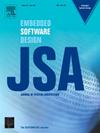A load-balanced acceleration method for small and irregular batch matrix multiplication on GPU
IF 3.7
2区 计算机科学
Q1 COMPUTER SCIENCE, HARDWARE & ARCHITECTURE
引用次数: 0
Abstract
As an essential mathematical operation, GEneral Matrix Multiplication (GEMM) plays a vital role in many applications, such as high-performance computing, machine learning, etc. In practice, the performance of GEMM is limited by the dimension of matrix and the diversity of GPU hardware architectures. When dealing with batched, irregular and small matrices, the efficiency of GEMM usually performs poorly. To this end, a common approach is to segment the matrix into multiple tiles and utilize parallelism between workgroups in GPU to compute the results. However, previous works only consider tile size and inter-workgroup parallelism and ignore the issues of low computational efficiency and hardware resource utilization caused by the difference in workloads between wavefronts. To address these issues, we propose a load-balanced batch GEMM acceleration method, consisting of a multi-thread kernel design and an efficient tiling algorithm. The multi-thread kernel design can address the workload unbalance between wavefronts in different workgroups, and the efficient tiling algorithm can choose the optimal tiling scheme with the new thread-level parallelism calculation method to achieve load-balanced task allocation. Finally, various comparative experiments were conducted on two GPU platforms: AMD and NVIDIA. Experimental results indicate the proposed method outperforms previous methods.
求助全文
约1分钟内获得全文
求助全文
来源期刊

Journal of Systems Architecture
工程技术-计算机:硬件
CiteScore
8.70
自引率
15.60%
发文量
226
审稿时长
46 days
期刊介绍:
The Journal of Systems Architecture: Embedded Software Design (JSA) is a journal covering all design and architectural aspects related to embedded systems and software. It ranges from the microarchitecture level via the system software level up to the application-specific architecture level. Aspects such as real-time systems, operating systems, FPGA programming, programming languages, communications (limited to analysis and the software stack), mobile systems, parallel and distributed architectures as well as additional subjects in the computer and system architecture area will fall within the scope of this journal. Technology will not be a main focus, but its use and relevance to particular designs will be. Case studies are welcome but must contribute more than just a design for a particular piece of software.
Design automation of such systems including methodologies, techniques and tools for their design as well as novel designs of software components fall within the scope of this journal. Novel applications that use embedded systems are also central in this journal. While hardware is not a part of this journal hardware/software co-design methods that consider interplay between software and hardware components with and emphasis on software are also relevant here.
 求助内容:
求助内容: 应助结果提醒方式:
应助结果提醒方式:


